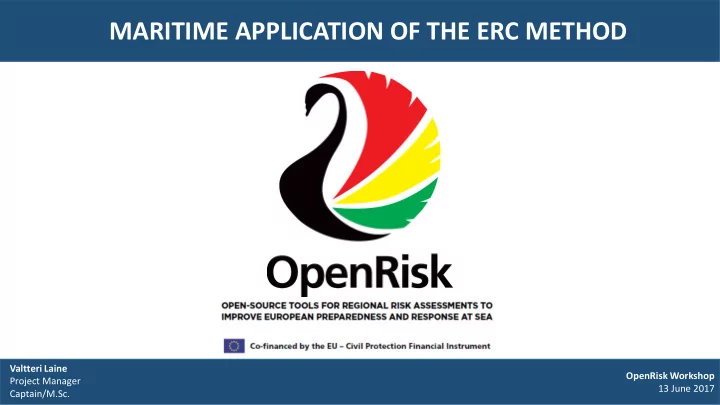

MARITIME APPLICATION OF THE ERC METHOD Valtteri Laine OpenRisk Workshop Project Manager 13 June 2017 Captain/M.Sc.
PERIODIC RISK ASSESSMENT Risk Identification • The organization should identify sources of risk, areas of impacts, events (including changes in circumstances) and their causes and their potential consequences. • The aim of this step is to generate a comprehensive list of risks based on those events that might create, enhance, prevent, degrade, accelerate or delay the achievement of objectives.
OVERVIEW • The Event Risk Classification (ERC) is a part of ARMS Methodology for Operational Risk Assessment. • It was originally developed for aviation by the ARMS Working Group from 2007 to 2010. • OpenRisk has develop consequence/probability matrices for environmental damages, loss of life or injuries and economic losses, and process for risk identification. • The expected end-users of this method are Pollution Prevention and Response authorities and VTS authorities.
EVENT RISK . • Risk that was present in an individual e x perienced event in a specific context. • These contextual factors will influence both the probabilities and severity levels of outcomes.
SAFETY ISSUE “ Manifestation of a hazard or combination of several hazards in a specific context” • Events that have something in common .
MARITIME APPICATION OF THE ERC Environmental Damages Loss of Life or Injuries Economical Losess Severity Very high risk High risk Risk Index Values Medium risk Likelihood Low risk
MARITIME APPICATION OF THE ERC Non-accident outcomes Accident outcomes SCENARIO • Question 1. If this event had escalated into an accident outcome, what would have been the most credible outcome?
MARITIME APPICATION OF THE ERC Non-accident outcomes Accident outcomes Question 2: What was the effectiveness of the remaining controls between this event and the most credible accident scenario?
PROCESS Data Collection VTS Incident Reports Marine Casualty Reports Accident Investigation Reports Pilotage Reports ... Structured Database • Date • Location (latitude/longitude) • Weather conditions (good/moderate/poor) • IMO number • Accident or scenario (grounding/collision/contact/fire or explosion…) • …
MARITIME ERC FOR THE RISK OF ENVIRONMENTAL DAMGES
MARITIME ERC FOR THE LOSS OF LIFE OR INJURIES
MARITIME ERC FOR THE RISK OF ECONOMICAL LOSESS
EXAMPLE 1: Engine failure January 2015 Economical Losess Environmental Damages Loss of Life or Injuries
EXAMPLE 2: Engine failure June 2016 Economical Losess Environmental Damages Loss of Life or Injuries
EXAMPLES OF OUTPUT Safety Issue: Engine failures Safety Issue: Collision risk between ropax ship and sailboat The events on different ship types from 2013 to 2014 in the Northern Baltic Sea (N=754).
EXAMPLES OF OUTPUT Spatial Distribution of Maritime Accidents and Spatial Cold Spots and Hot Spots Based on Incidents and Their Event Risk Values Safety Issue : Accidental hotspot area The events from 2013 to 2014 in the Northern Baltic Sea (N=754).
BOWTIE METHOD Valtteri Laine OpenRisk Workshop Project Manager 13 June 2017 Captain/M.Sc.
PERIODIC RISK ASSESSMENT Risk Analysis • Risk analysis involves developing an understanding of the risk. Risk analysis provides an input to risk evaluation and to decisions on whether risks need to be treated, and on the most appropriate risk treatment strategies and methods. • Risk analysis can also provide an input into making decisions where choices must be made and the options involve different types and levels of risk.
OVERVIEW • Simple diagrammatic way of describing and analysing the pathways of a risk from causes to consequences • Combination of Fault Tree and Event Tree analysis • Focus of the bow tie is on the barriers between the causes and the risk, and the . risk and consequences • Often used in combination with the ERC method • Easy to understand and useful communication tool
PROCESS Identified risk Identified potential Sources of risk (hazards) consequences Identified mechanism Identified mechanism Identified prevention Identified mitigation controls and robustness and recovery controls and robustness Identified escalation factors Identified escalation factors Identified owners of controls Identified owners of controls Data collection: Accident statistics, VTS Incident reports, expert judgements, studies...
SCOPE AND LEVEL OF ABSTRACTION • Determining scope • Level of abstraction
EXAMPLE OF PREVENTION Based on risk identification Robustness?
EXAMPLE OF RESPONSE Based on risk identification Owner of controls?
THANK YOU FOR YOUR ATTENTION AND BE SAFE! HELCOM Baltic Marine Environment Protection Commission Katajanokanlaituri 6 B, FI-00160 Helsinki, Finland Valtteri Laine Project Manager Tel: +358 40 3527 689 E-mail: valtteri.laine@helcom.fi
Recommend
More recommend